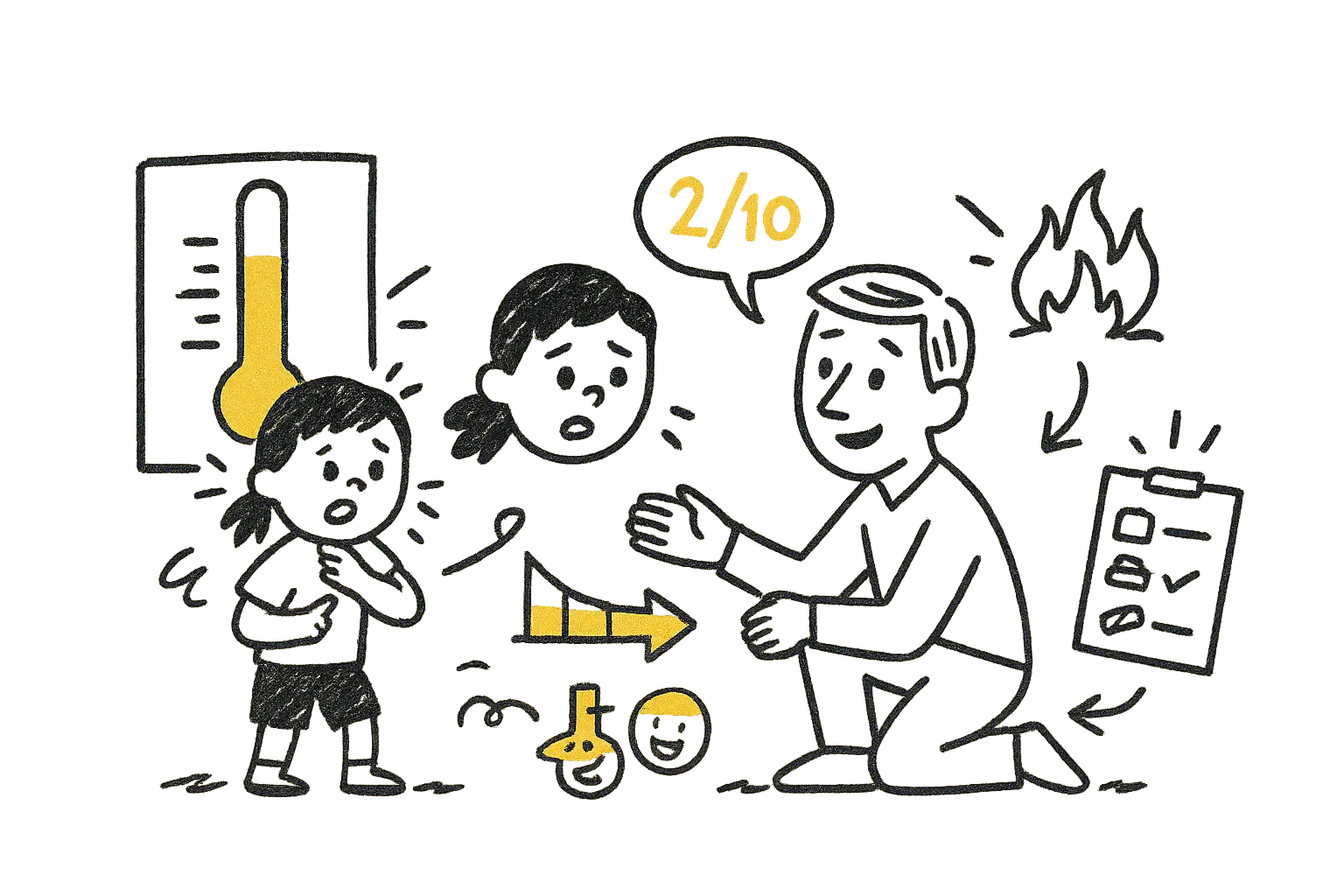Teaching Kids How to Ride the Waves of Fear

The first time the emergency alerts blasted across our phones this summer, my daughter froze. She looked at me with wide eyes and whispered, “Is our house going to burn down?”
That’s the thing about fear—it lands suddenly and feels absolute. In her mind, the alert meant fire, fire meant danger, and danger meant losing everything. And for a kid, those dots connect instantly. My job in that moment wasn’t to say, “Don’t worry” (which never works). It was to help her put the fear into perspective.
So I told her, “I’m worried, too. But only at about a 2 out of 10.”
That simple number wasn’t a throwaway. Therapists use something called the Subjective Units of Distress Scale (SUDS)—basically a 0–10 ruler for emotions. Zero means totally calm, ten means absolute panic. The beauty of SUDS is that it turns a vague, overwhelming feeling into something you can measure. When fear becomes a number, kids realize it can move up or down—and that they can influence it.
In child therapy, clinicians often adapt SUDS into a “feelings thermometer.” A poster might show a thermometer with colors: green at the bottom (calm), yellow in the middle (nervous), red at the top (very scared). Kids point to the “temperature” that matches how they feel. Over time, they learn that just noticing the number can lower the intensity.
When I told my daughter I was at a “2,” I was modeling both honesty and control: “Yes, I feel fear—but it’s low. Manageable.” And she could borrow that steadiness.
Fear as Teacher, Not Enemy
Fear is built into us. It’s one of the oldest survival systems in the brain, and for kids especially, it shows up fast and strong. The CDC now estimates that 11% of U.S. children (ages 3–17) had current, diagnosed anxiety in *2022–2023. Anxiety is common—and treatable—but kids need tools to work with fear instead of getting swallowed by it.
Resilience researchers remind us that the goal isn’t to erase fear. It’s to give kids ways to interpret and ride it. Ann Masten calls this “ordinary magic”—the everyday processes of support, perspective, and self-regulation that help children adapt and even thrive, despite stress.
Sorting the Controllable from the Uncontrollable
After we talked about the number scale, I took it a step further. I told her there are things we can’t control—the fire itself, the rolling blackouts, the thick smoke in the air. Then there are things we can—like our plan.
So her mom and I talked through contingencies: if the fire spread, where we’d go, what we’d bring, who we’d call. Psychologists call this “locus of control.” Studies in school-age kids link a more internal locus of control and better self-control with fewer internalizing problems like anxiety and depression.
By drawing that line—what’s ours to handle, what’s not—I could see her shoulders relax. She didn’t have to hold it all.
The Power of Letting Go
Here’s the counterintuitive part: once you’ve handled the controllables, you actually get a break. There’s nothing else you can do, so the nervous system doesn’t need to stay revved up. That’s when you can eat pizza.
Literally, in our case. After making our plan, we went out for dinner, and then I drove her and her brother to the cabin—less smoke, water running, power on. We stayed up late, watched a movie, laughed.
The American Academy of Pediatrics calls play a uniquely powerful way to build self-regulation and buffer toxic stress. When kids get to return to fun after fear, it helps their bodies reset.
That night could have been remembered as the night of the scary fire alerts. Instead, she’ll probably remember pizza and a movie marathon.
Modeling Calm
Of course, none of this works if I had panicked. Kids co-regulate with adults—they “catch” our nervous systems. Calm caregivers literally help children’s bodies settle and learn how to settle themselves.
By calmly saying, “I’m at a 2/10,” I wasn’t hiding my worry—I was containing it. That gave her both a role model and a safe anchor.
What I Took Away
That night reminded me that fear isn’t something we erase for our kids. It’s something we help them ride. I don’t think my daughter will forget the fire alerts. But she also won’t forget that her family had a plan, that her dad wasn’t panicked, and that scary nights can end in laughter.
And maybe that’s the real lesson: when kids face fear, we can guide them through three simple moves. Looking back, I realized we’d already used them without naming them. Now I call it the 3R Framework: Rate, Regroup, Release.
The 3R Framework: Teaching Kids to Ride the Waves of Fear
1. Rate (Give Fear a Number)
- Ask your child to put their fear on a 0–10 scale (a “feelings thermometer”).
- Share your own number out loud to model calm containment.
- Why it helps: Makes fear measurable and less overwhelming.
2. Regroup (Sort What We Can Control vs. What We Can’t)
- Split the situation into two buckets: controllables vs. uncontrollables.
- Focus energy where it counts—your plan, your actions.
- Why it helps: Builds resilience by teaching kids where their effort matters.
3. Release (Let Go and Re-Engage in Life)
- Once you’ve handled the controllables, give yourself permission to move on.
- Play, laugh, reconnect—it resets the body’s alarm system.
- Why it helps: Play and joy are proven buffers against toxic stress.
Overlay: Model Calm. Kids take their cues from us. If we can contain our own fear—even while admitting we feel it—we give them an anchor for their own nervous systems.
References
- CDC. (2025). Data and Statistics on Children’s Mental Health (2022–2023).
- Wolpe, J. (1969). The Practice of Behavior Therapy. (Introduced SUDS scale).
- Benjamin, C. L., et al. (2010). Evidence-based treatments for child anxiety in clinical practice. Journal of Anxiety Disorders, 24(7), 835–842.
- AACAP. (2020). Clinical Practice Guideline for the Assessment and Treatment of Children and Adolescents With Anxiety Disorders.
- American Academy of Pediatrics. (2018). The Power of Play: A Pediatric Role in Enhancing Development in Young Children. Pediatrics, 142(3), e20182058.
- Center on the Developing Child, Harvard University. (2015). Toxic Stress.
- Murray, D. W., et al. (2016). Self-regulation and toxic stress: Foundations for understanding self-regulation from an applied developmental perspective. OPRE Report.
- Masten, A. S. (2001). Ordinary magic: Resilience processes in development. American Psychologist, 56(3), 227–238.
- Rotter, J. B. (1966). Generalized expectancies for internal versus external control of reinforcement. Psychological Monographs: General and Applied, 80(1), 1.
- Wray-Lake, L., et al. (2019). Associations among locus of control, self-control, and internalizing problems in youth. Frontiers in Psychology, 10, 1507.


Member discussion